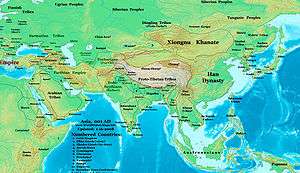Protectorate of the Western Regions

The Protectorate of the Western Regions (simplified Chinese: 西域都护府; traditional Chinese: 西域都護府; pinyin: Xīyù Dūhù Fǔ; Wade–Giles: Hsi1-yü4 Tu1-hu4 Fu3) was an imperial administration imposed by Han China – between the 2nd Century BCE and 8th Century CE – on many smaller and previously independent states, which were known in China as the "Western Regions" Chinese: 西域; pinyin: Xīyù; Wade–Giles: Hsi1-yü4).[1]

"Western Regions" referred mostly to areas west of Yumen Pass, especially the Tarim Basin. These areas were later regarded as Altishahr (southern Xinjiang, excluding Dzungaria).[2] Previously, "western regions" was used more generally in regard to Central Asia and sometimes even included parts of South Asia.
The protectorate was the first direct rule by a Chinese government of the area.[2][3] It comprised various vassal protectorates, under the nominal authority of a Chief Protector of the Western Regions, appointed by the Han court.
History
In the Han–Xiongnu War of the 2nd Century BCE the Chinese state established a military seat at Wulei (near present-day Cedaya 策达雅, in Bugur/Luntei County). Their aim was to control the diverse peoples and cultures of the Western Regions at the time, including several originating in Western Eurasia and/or spoke Indo-European languages. These peoples included the Tocharian-speaking city states, such as Ārśi (Arshi; later Agni/Karasahr), Kuča (Kucha), Gumo (later Aksu), Turfan (Turpan), Loulan (Krorän/Korla). By controlling the Western Regions, the Chinese would also keep the Xiongnu away from Inner China. The peoples of oasis city-states of Khotan and Kashgar spoke the Saka language, one of the Eastern Iranian languages.[4]
The seat was later shifted to Taqian (or Tagan; near modern Kucha), during the Eastern Han dynasty.[5]
Officially established in 59 or 60 BCE, Protector-General was the highest military position in the west during its existence. During its peak in 51 BCE, the Wusun nation was brought under submission.[3] After at least 18 different protector generals, of whose names only 10 of their names are known, the post was abandoned, by the time of Wang Mang's Xin dynasty
In 74 CE, Emperor Ming of Han and his successor awarded the position (now with administrative obligations as well) to general Chen Mu. From 83 CE and the appointmnet of Ban Chao, the Protector-General was known as the Chief Official of the Western Regions.
On 29 July 107, a series of Qiang uprisings in the areas of Hexi Corridor and Guanzhong forced the abandonment the post,[5] although it was resumed in 119.
In the 7th Century, a successor administration, the Protectorate General to Pacify the West was established at Xizhou (Turpan) and moved later to Kucha.
Coins from the period, with inscriptions in both Chinese and the Kharoshthi script used by local Indo-European languages, have been found in the southern Tarim Basin.[6]
List of Protector-Generals
Western Han and Xin
- Zheng Ji 60-48 BCE
- Han Xuan (韓宣) 48-45 BCE
- Unknown (3rd) 45-42 BCE
- Unknown (4th) 42-39 BCE
- Unknown (5th) 39-36 BCE
- Gan Yanshou (甘延壽) 36-33 BCE
- Duan Huizong (段會宗) 33-30, 21-18 BCE
- Lian Bao (廉褒) 30-27 BCE
- Unknown (9th) 27-24 BCE
- Han Li (韓立) 24-21 BCE
- Unknown (11th) 18-15 BCE
- Guo Shun (郭舜) 15-12 BCE
- Sun Jian (孫建) 12-9 BCE
- Unknown (14th) 9-6 BCE
- Unknown (15th) 6-3 BCE
- Unknown (16th) 3 BCE-1 CE
- Dan Qin (但欽) 1-13 CE
- Li Chong 13-23 CE
Eastern Han
In popular culture
- Dragon Blade, a 2015 film starring Jackie Chan and John Cusack, tells the story of one of the commanders (Chan) of the Protectorate of the Western Regions, who after being framed and sentenced to hard labour at one of the frontier fortresses, and strives to keep the peace among members of the various nations. He befriends a Roman legionary (Cusack) fleeing along the Silk Road, and his desire for peace and non-violence conflicts with his sense of honor and desire to save his new friend.
Maps
|
See also
References
Citations
- ↑ Tikhvinskiĭ, Sergeĭ Leonidovich and Leonard Sergeevich Perelomov (1981). China and her neighbours, from ancient times to the Middle Ages: a collection of essays. Progress Publishers. p. 124.
- 1 2 "Xiyu Duhu"
- 1 2 Yu 2003, 57-59
- ↑ Xavier Tremblay, "The Spread of Buddhism in Serindia: Buddhism Among Iranians, Tocharians and Turks before the 13th Century," in The Spread of Buddhism, eds Ann Heirman and Stephan Peter Bumbacker, Leiden: Koninklijke Brill, 2007, p. 77.
- 1 2 Yu 1995, 56, 68-71
- ↑ James A. Millward (2007). Eurasian Crossroads: A History of Xinjiang. Columbia University Press. pp. 23–. ISBN 978-0-231-13924-3.
Sources
- Ma, Yong, "Xiyu Duhu" ("Protector General of the Western Regions"). Encyclopedia of China (Chinese History Edition), 1st ed.
- Yu, Taishan. A Study of the History of the Relationship Between the Western and Eastern Han, Wei, Jin, Northern and Southern Dynasties and the Western Regions. Chinese Academy of Social Sciences, June 1995. Sino-Platonic Papers, Oct, 2006.
- Yu, Taishan (2nd ed, 2003). A Comprehensive History of Western Regions. Zhengzhou: Zhongzhou Guji Press. ISBN 7-5348-1266-6.
External links
Part of a series on the |
|---|
| History of Xinjiang |



